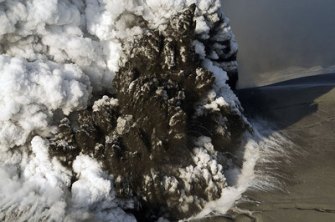Airspace begins to open as Eyjafjallajökull calms down

nEyjafjallajokull erupting on 4/17/2010, image by Marco Fulle. Note the “rooster tails” of ash and steam, typical for Surtseyan eruptions.
nn
European airspace has slowly begun to reopen as the explosive eruptions at Eyjafjallajökull have become less intense over the last 24 hours. However, there is still lots of hazardous airspace and airports around places like London and across the UK remain closed – leaving people stranded. We will still have to wait to see what the political ramification are, especially after EU officials claim “flaws” in their decision and the over $1 billion losses by the airlines. There is still a persistent 3,000-4,000 meter ash plume coming from the crater, which isn’t too surprising considering the strombolian-style activity, which can also have periods of reinvigorated activity. You can see some of this style of eruption in the webcam capture from last night (below) – you can make out the incandescent blocks and ash being thrown from the crater. It is hard to get a scale out of the image, but the blocks could be meter-scale chunks of lava coming up in the vent. You can get another perspective on these spasmodic explosions by watching the video taken from a helicopter yesterday, showing a “pressure wave” that represents one of these explosions occurring in the crater. Each explosion is a large “bubble” of volatile gases in the magma escaping at the vent, causing fragmentation of the magma and the explosion we see. This might also explain some of the loud explosions that have been reported today near the volcano.
nn
nEyjafjallajokull exhibiting strombolian-style eruption on the night of 4/20/2010.
nn
All eyes, including satellites, have been trained on Eyjafjallajökull over the last week. Two pictures posted yesterday at the NASA Earth Observatory show the changing ash plume from the volcano over the weekend. The BBC has posted a nice collection of satellite images as well that capture the range of remote sensing we have up in orbit. There is an amazing collection of land-based pictures as well on the Big Picture – and check out another fellow Scibling if you’re curious about the volcanic lightning. You have to be impressed with the response of the Icelandic officials and people to this eruption, even with some dry Scandinavian wit: “It seems we’re getting pretty good at exporting our disasters.” If you want to read my take on the threat of ash to airlines, you can check it out on Dot Earth over on the New York Times website – and nothing like people seeing faces wherever they can find them.
nn
More updates as they arrive …
nn
UPDATE 1: If you want more video of the “shockwaves” at the crater, this video was recorded by Omar Ragnarsson at 5 o’clock GMT this morning. Stunning stuff. {Hat tip to Palmi Egilsson.}
nn
UPDATE 2: The ash plume might have cost the US economy ~$650 million according to U.S. Travel Association.





